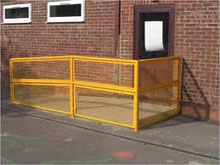
Access Ramps Resources
- Home
- Types of Access Ramps
- Access Ramps for Disabled
- Access Ramps for Sale
- Access Ramps for Wheelchairs
- Ada Access Ramps
- Building Access Ramps
- Disability Access Ramps
- Disabled Access Ramps
- Disabled Access Ramps Regulations
- Easy Access Ramps
- EZ Access Ramps
- FAQs Access Ramps
- Handicap Access Ramps
- Handicapped Access Ramps
- Lightweight Access Ramps
- Modular Access Ramps
- Portable Access Ramps
- Portable Disability Access Ramps
- Vehicle Access Ramps
- Wheelchair Access Ramps
Access Ramps for Disabled
The Americans With Disability Act (ADA) has revolutionized the civil rights of the disabled or physically impaired. Prior to this Act being made, law on access ramps for disabled were not mandatory in public buildings and other instances. In fact, wheelchair users had to make their own arrangements for wheelchair access. However, since the enactment of the Americans With Disability Act, public buildings have to include access ramps for disabled in their new building plans and have to alter older buildings to conform with the law. As a result, architects have worked with planners and building owners to create wheelchair friendly access in a multitude of buildings. This includes private offices and dwellings as well as larger corporate and public buildings.
Access ramp regulations
If a building has to provide access ramps for the disabled they must be fit for purpose. A ramp cannot be steep or sloping at an angle that is too difficult to traverse. In fact, the ramp should not rise above 1 inch for every 18 inches of length. The maximum length of the ramp in a straight line should not exceed 30 inches and there should be a flat platform at the top and bottom of the ramp. The flat landing at the top of access ramps for disabled should be at least 60 inches to ensure a wheelchair can adequately rest on it without slipping back down the ramp. It goes without saying that the flat platform should be the same width as the ramp itself. The Americans With Disability Act also states that there should be handrails on either side of the ramps and the height of these should be between 30 inches and 38 inches.
Children with disabilities
Of course, children have disabilities too and the Americans With Disability Act governs playground facilities to ensure they can take part in normal childhood activities. Playgrounds are public places and as such, they are maintained for safety of all children, including those with disabilities. Access ramps for disabled children are provided where there is a difference in surface heights to ensure they can reach the decks. The slope of a ramp should be 1 foot to every 12 feet in length. The access ramps must have handrails, as with other access ramps, and children should have access to at least half of all play areas if there are less than 20 different items in the playground or park. If there are more than 20 then access to 25% of them should be readily available. To be able to comply with the law and build access ramps for disabled children, playground decks are being made larger and with shorter stairs. In fact, this consideration for children who are wheelchair users has made playgrounds safer for everyone.
Accessible routes
One of the great advantages of cooperation with the law is that routes are made safer for everyone. In addition to access ramps for disabled, pathways and routes are also safer as they are wider and have a gradual sloping edge to the pathways to prevent wheelchair slippage
